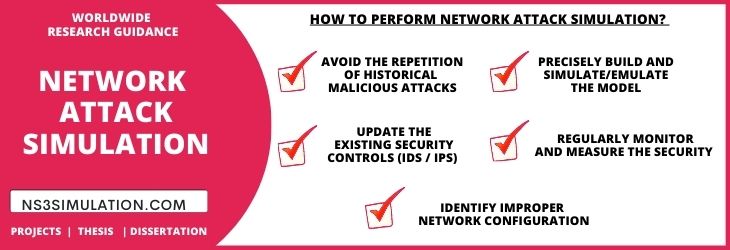In recent days, the primary threat to network security is a network attack. To tackle this threat, advanced security testing mechanisms are introduced. In that, network attack breach simulations are growing fast. This type of simulation simulates the strategies of attacks to analyze the actual behaviour and intention over network information. And also, it identifies the vulnerable points that attacker uses to launch the attacks. Overall, it delivers security warning services to authenticated users to prevent further attacks. By the by, Network Attack Simulation Projects measures the efficiency of the cyber security systems.
This page is prepared with the intention to convey more information on network attacks and simulation!!!
In a real-world environment, an efficient network attack simulation model endlessly monitors the networks, simulates the attacks, computes degrees of defensive techniques optimizations, measures the impact of network attacks, etc.
To simulate the whole cyber system, attack simulators, and malware link with terminal devices. Then, it enables to verify of the network security framework by entity behavior, lateral mobility, malware broadcast, control, defect, commands, etc. On one side, network attacks aim to stop organizational operations. On another side, the aim of malware (worms, Trojan horses, and viruses) is to corrupt / destroy data and network shutdown. Here, we have given in what way the simulation of network attacks executed.
How to perform network attack simulation?
- Avoid the repetition of historical malicious attacks / incidents
- Precisely build and simulate / emulate the model of network attack
- Update the exiting security controls (IDS / IPS) to enhance the system performance
- Regularly monitor and measure the security mechanisms behavior
- Identify improper network configuration and fix those gaps through appropriate actions
Prior to getting deep into the network attack, it is essential to know the types of network attacks first. Basically, the network attacks are divided into two major classifications. And, they are active and passive attacks where the differential aspects of these attacks are given below;
Major types of network attacks
- Active
- Get the network accessibility in the absence of legal user approval
- After accessing, the attackers can encrypt, manipulate, delete, collapse, corrupt and destroy data with an intention to affect data for own purposes
- Passive
- Get the network accessibility in the absence of legal user approval
- After accessing, the attackers overhear, monitor or steal the network data without affecting original data
In addition, we have also given the different categories of attacks. These categories specify the intention of the attacks in the network. For your information, here we have specified only 3 major attacks. Once you connect with us, we let you know the solutions for these attacks.
What are the three major categories of network attacks?
- Access Attacks
- It aims to acquire the accessibility of the network internal system for performing malicious activities
- Denial of Service Attacks
- It targets to make network busy by creating heavy traffic for legal users. So, the users are unable to access their requested on-time
- Reconnaissance Attacks
- It intends to collect the useful information from network without affecting the network data
We hope that you are clear with the network attacks fundamentals from the above section. Now, we can see about what are the entities used in the network security model and what the attacker’s intentions are. In this model, the attacker chooses the vulnerable points to establish the attacks. Then, the attacks perform the techniques to provide network information to the attackers.
How does network security model works?
- Network
- Firewalls
- Machines
- Services
- Other security measures
- Attacker
- Modus Operandi
- Network information
- Intention
- Perform aimed services
- Achieve mission objectives
- Apply attack techniques
To develop the above-discussed model, simulation tools are used. This tool helps to simulate network attacks in the huge-scale network. This huge-scale network will comprise 1000+ hosts, vulnerable points, applications, etc. for achieving the real behaviour of attackers. Majorly, the good model relies on computer intrusion for realistic attacks investigation. Specifically, we help you to understand the network vulnerabilities and transmission channels. Firstly, know the following key terminologies in the network attacks to know more about network attacks
Important Terms in Network Attacks
- Network Datasets
- Network Threats
- Network Protocols
- Network Deep Learning Techniques
- Network Architecture
- Network Machine Learning Techniques
- Network Security Design Adoptions
Furthermore, we have also included the different network threats/vulnerabilities and attacks that earn high popularity in the current research community. Our resource team is furnished with all possible solutions for these attacks. Beyond these attacks, we also support you in other attacks as well with apt solutions.
Network Threats and Attacks
- Tampering
- Manipulating transmitting data
- Privileged Elevation
- WLAN Openness
- Spoofing
- Man-in-the-Middle attack
- Unapproved Access point accessibility
- Denial of Service
- Jamming signal attacks
- Priority Access Point Escapism
- Information Revelation
- Data Theft
- Attack on High Priority Access Point (AP)
- Repudiation
- Denial of user accountability (security, access, resource, etc.)
In the earlier section, we have seen the significant terms of network attacks. Now, we can see the terminologies used in the network attack simulation. Since these terms are related to the development of the network attack model. So, it is essential to know for implementing network attacks projects.
What are the terminologies for Network Attacks Simulation?
- Infrastructure
- Ad-hoc Network
- Wired Network
- And many more
- Data Source
- Network and Host-based
- Host-based
- Network-based
- System Construction
- Centralized
- Decentralized
- Attack Identification Time
- Offline and Online
- Attack Detection Techniques
- Specification-based
- Signature-based
- Hybrid-based
- Anomaly-based
Our developers are adept to develop a wide variety of well-structured network attack models through suitable development tools and technologies. Further, we also assist you to choose a more apt simulation tool for your projects. For your information, here we have given you our ambitions in implementing network attacks projects.
Our Objectives in Network Attacks Projects
- Frame common specifications to detect various attacks which associated with different methods
- Perform model checking for standard validation of hardware and software
- Define the model specification by suspected network conditions
- Define the model by pre-defined attacker and protocol’s behavior
- Design automated techniques to detect attacks in network protocols
- Construct the model in two below aspects
- Acceptably compact – enhance feasibility and user-friendliness of model checking tools
- Acceptably comprehensive – utilize protocol behaviors to detect the attacks
How does attacker involved in the network?
The first step ofproject execution after tool selection is data collection. So, here our developers have given you essential details about data collection.
Data Collection – Most probably, attacks are aimed to gain knowledge of the targeted network in terms of services, OS, IP addresses, transmitting data, etc. And, some of the main events executed on data collection are given as follows,
- OS Identification
- By examining response of remote host for specific tests, one can identify its operating system
- For identification, it utilizes “Neural network” and “Nmap’s fingerprinting” database to precisely relate the remote host response with already stored signatures
- Further, it also include other utilities that depends on specific conditions
- For example: SMP and DCE-RPC protocols identify windows based VMs
- Port Scanning
- Monitor whole network to scan and get open and closed ports of deployed host / virtual machines
- Network Discovery
- Identify the network through suitable pre-determined techniques such as passive discovery, ICMP echo request, ARP, TCP connect and TCP SYN packets
- Other Human Attackers Strategies
- Utilize publically available information to gain interpretation of aimed organization. And, main strategies are as follows:
- Google Hacking
- Social Engineering
- Utilize publically available information to gain interpretation of aimed organization. And, main strategies are as follows:
Now, we can see the overall steps involved in modelling network attack simulation. IT delivers you full processes of project development starting from simulation tool selection to experimental result analysis of ad hoc simulation. Here, we have given only common 4 steps further our developers will assist you precisely depends on the project requirements.
Four-Step Method for Network Attack Simulations
- Simulation Tool Selection
- At first, we will select the appropriate tool that fulfill your application needs such as workstations, internal infrastructure, databases, sophisticated attack surface, and many more.
- And, some of the simulators that are appropriate for network attack simulations are given as follows:
- NS3
- Exata
- OMNET++
- Mininet
- NS2
- QualNet
- GNS3
- GlomoSim
- OPNET
- Attack Surface Designing
- Design the model with accurate time-synchronization and time-stamped data
- Efficiently manage the data transferring time-stamps at run-time
- Measures the time-synchronization of model throughput the execution
- Maintenance of global time to prevent the causality breach
- Compute the performance of model at different timestamps
- Simulation Testing / Verification
- Next, we perform simulation test at different network configuration settings, design entities, infrastructure, timestamps, network capacity, etc.
- This helps to find and compare the network performance metrics and entities behaviors at different scenarios for identifying maximum efficiency
- Performance Evaluation
- At last, we analyze the overall performance of the network attack model.
- In order to precisely identify the efficiency of model, we use appropriate simulation and network parameters depend on project requirements.
- Since, the parameters vary based on simulation scenarios.
- Below, we specified parameters that used to analyze the impact of network protocols at different settings.
- Packet Loss
- Throughput
- Mean Hop Count
- End-to-end Latency
- Packet Delivery Ratio
- Average Routing Overhead
Overall, the network attack simulation model produces the outcome by means of attack vector type and route probabilities from the attacker’s viewpoint. And also, it figures out the risky point of organizational network with best-fitting Network Attack Simulation solutions. To the end, this model simplifies and automates the processes in the network.
Conclusion
Before the simulation, applying analytical methods are a quite challenging job for predicting every attack. It takes large complicated computations to execute the analytical study. So, the Network Attack Simulation method is introduced to make this process simple and effective. It provides benefits in multiple ways such as simulating network attacks, predicts attack effects, set network configuration, building control systems, attack verification, redundancies, fault analysis, etc.
On the whole, if you are looking for the best research and development guidance then create a bond with us. We will take whole responsibilities of your network attacks project till you reach your destination.


